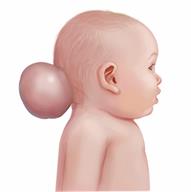When Your Baby Is Born With Part of the Brain Outside of the Skull (Encephalocele): What to Know

An encephalocele is a problem that is present at birth (congenital defect) in which an opening in the skull allows a section of the brain and its coverings (meninges) to bulge out into a sac. Most encephaloceles stick out (protrude) from the back of the skull. Some are not visible because they are in the forehead or sinus area.
An encephalocele is a type of neural tube defect. The neural tube is what develops into the baby's brain and spinal cord during pregnancy. An encephalocele can be associated with other conditions, such as a cleft lip or palate, extra fingers or toes, kidney problems, or genital defects. Often, the combination of conditions can indicate a specific syndrome. Children who have had an encephalocele may need therapy to help them deal with complications from the condition.
What are the causes?
The cause of this condition is not known.
The defect forms during pregnancy, in the earliest stages of fetal development. It may be genetic, which means that it can be passed from parent to child. Other causes might be environmental factors or certain infections during pregnancy.
What are the signs or symptoms?
An encephalocele is usually visible at birth as a bulge or lump. Signs and symptoms may include:- Delayed growth and development or learning difficulties.
- Jerky movements that cannot be controlled (seizures).
- Vision problems.
- Head size that is smaller than normal.
- Weakness, loss of use, or stiffness of the arms and legs.
- Uncoordinated movements related to walking and reaching (ataxia).
- Breathing problems.
Signs and symptoms will depend on many factors, such as the location and size of the defect, and any other abnormalities that may be present.
How is this diagnosed?
Usually, this condition is diagnosed with an ultrasound before your baby is born. If your health care provider thinks that your unborn baby may have a birth defect, he or she may recommend a procedure to remove and test a small amount of the fluid that surrounds your baby in your uterus (amniocentesis).
This condition may also be diagnosed at birth, when the sac becomes visible. Rarely, a small encephalocele in the forehead or sinus area of the face is not found until symptoms develop. If your child's health care provider thinks that your child has an encephalocele that is not visible, your child may have imaging tests, including:- Ultrasound.
- CT scan.
- MRI.
- X-ray.
How is this treated?
This condition is treated with surgery. Depending on the severity, surgery may be done right after your child is born or may be done a few months after birth. Sometimes multiple surgeries are needed. Surgery involves removing the sac, removing any injured brain tissue, placing the protruding brain tissue back into the skull, and repairing any defects in the skull. This will help to avoid the development of a life-threatening infection or injury to the brain tissue.
Other abnormalities may also be corrected through surgery. If your child has hydrocephalus, a tube (drain) may be placed in the skull to remove the fluid and prevent pressure from damaging the brain.
Follow these instructions at home:
-
Learn as much as possible about encephaloceles. This can help you make treatment decisions and know what to expect.
- If your child does not have surgery right after birth, follow instructions from your health care provider about:
- Keeping your baby safe.
- Protecting your baby's head.
- Feeding your baby.
- Comforting your baby.
-
Give your child over-the-counter and prescription medicines only as told by your child's health care provider.
-
Keep all follow-up visits. This is important.
Where to find more information
Centers for Disease Control and Prevention: www.cdc.gov
Contact a health care provider if:
-
Your child has repeated upper respiratory tract infections.
-
Your child has a fever.
-
Your child vomits.
Get help right away if:
-
Your child who is younger than 3 months has a temperature of 100.4°F (38°C) or higher.
-
Your child who is 3 months to 3 years old has a temperature of 102.2°F (39°C) or higher.
-
Your child has an unexpected change in behavior.
-
Your child has a seizure.
Summary
-
An encephalocele is a problem that is present at birth (congenital defect) in which an opening in the skull allows a section of the brain and its coverings (meninges) to bulge out into a sac.
-
Children who have had an encephalocele may need therapy to help them deal with complications from the condition.
-
It is important to learn as much as possible about encephaloceles. This can help you make treatment decisions and know what to expect.
-
This condition may be diagnosed using an ultrasound before the baby's birth. In other cases, the sac is noticed after birth. Rarely, a small encephalocele in the forehead or sinus area of the face is not found until symptoms develop.
-
This condition is treated with surgery. Surgery involves removing the sac, removing injured brain tissue, placing the protruding brain tissue back into the skull, and repairing any defects in the skull.
This information is not intended to replace advice given to you by your health care provider. Make sure you discuss any questions you have with your health care provider.

